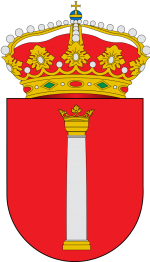Colonna family: Difference between revisions
No edit summary |
No edit summary |
||
| Line 1: | Line 1: | ||
;[[Rome -- medieval]] | ;[[Rome -- medieval]] | ||
[[File:Roman Colonna coat of arms.png]] | [[File:Roman Colonna coat of arms.png|150px]] | ||
<br> | <br> | ||
<br> | <br> | ||
Latest revision as of 18:57, 12 January 2018
Introduction
The Colonna family, also known as Sciarrillo or Sciarra, is an Italian noble family. It was powerful in medieval and Renaissance Rome, supplying one Pope and many other Church and political leaders. The family is notable for its bitter feud with the Orsini family over influence in Rome, until it was stopped by Papal Bull in 1511. In 1571, the heads of both families married nieces of Pope Sixtus V. Thereafter, historians recorded that "no peace had been concluded between the princes of Christendom, in which they had not been included by name".
History
According to tradition, the Colonna are a branch of the Counts of Tusculum — by Peter (1099–1151) son of Gregory III, called Peter "de Columna" from his property the Columna Castle in Colonna, Alban Hills. Even far further back, they trace their lineage past the counts of Tusculum via Lombard and Italo-Roman nobles, merchants, and clergy through the Early Middle Ages — ultimately claiming origins from the Julio-Claudian dynasty.
The first cardinal from the family was appointed in 1206 when Giovanni Colonna di Carbognano was made Cardinal Deacon of SS. Cosma e Damiano. For many years, cardinal Giovanni di San Paolo (elevated in 1193) was identified as member of the Colonna family and therefore its first representative in the College of Cardinals, but modern scholars have established that this was based on the false information from the beginning of 16th century.
Giovanni Colonna, nephew of Cardinal Giovanni Colonna di Carbognano, made his solemn vows as a Dominican c. 1228 and received his theological and philosophical training at the Roman studium of Santa Sabina, the forerunner of the Pontifical University of Saint Thomas Aquinas, Angelicum. He served as the Provincial of the Roman province of the Dominican Order and led the provincial chapter of 1248 at Anagni. Colonna was appointed as Archbishop of Messina in 1255.
In 1248, after having dedicated her entire life to serving God and the poor, Margherita Colonna died. A member of the Franciscan Order, she was beatified by Pope Pius IX in 1848.
At this time a rivalry began with the pro-papal Orsini family, leaders of the Guelph faction. This reinforced the pro-Emperor Ghibelline course that the Colonna family followed throughout the period of conflict between the Papacy and the Holy Roman Empire.
